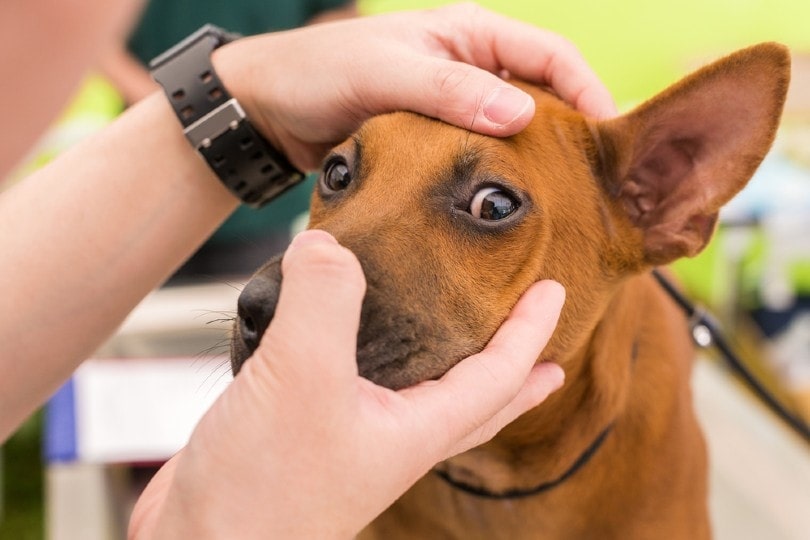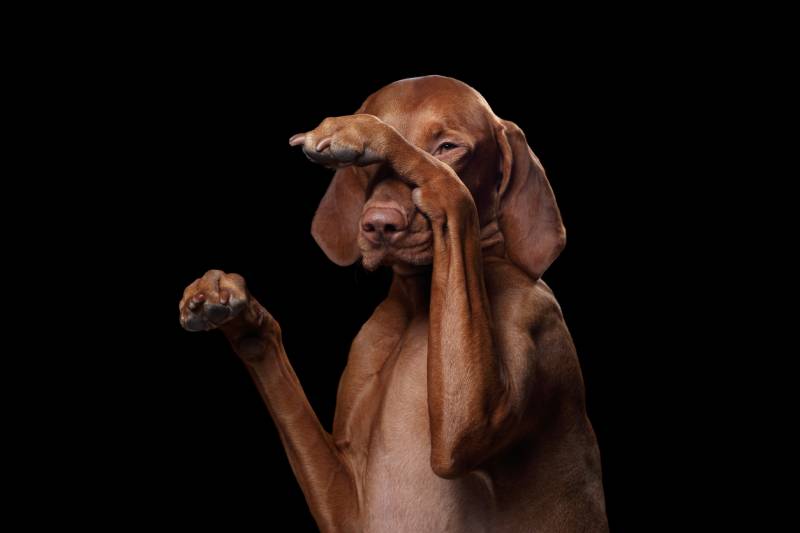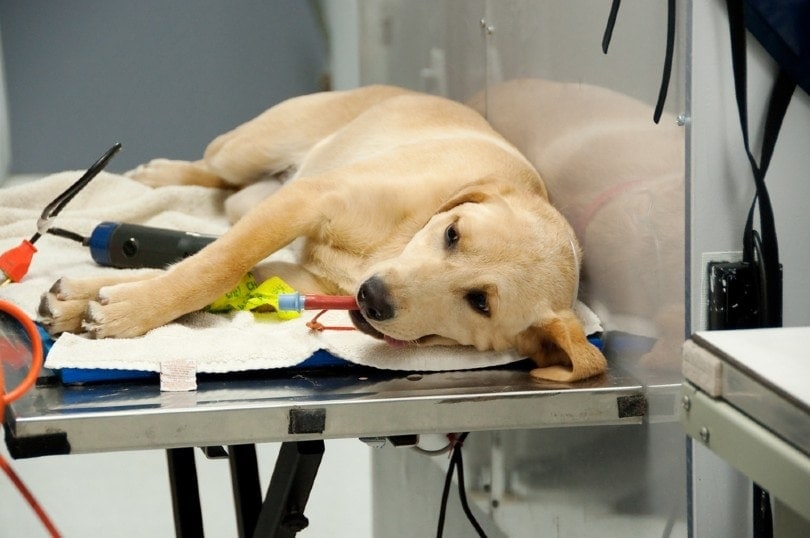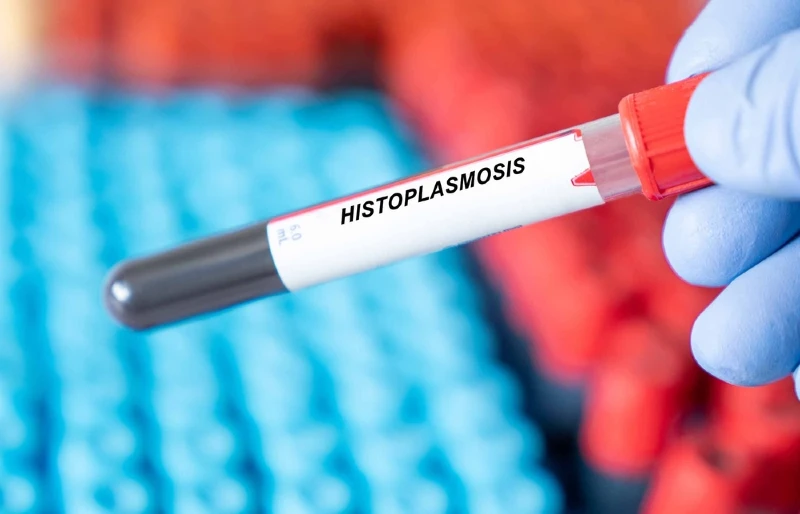Why Are My Dog’s Eyes Red & Bloodshot? Our Vet Discusses Causes & Health Tips
Updated on

Click to Skip Ahead
It can be quite upsetting to notice your canine’s usually bright eyes slowly turning red and bloodshot. But just like us humans, dogs also experience bloodshot eyes. What makes the eye look bloodshot in most circumstances is the inflammation of the conjunctiva, the thin layer that lines the eyeball and the eyelids. The conjunctiva is semi-transparent when not inflamed.
There are numerous reasons for this condition. For instance, some dogs may suffer from infection, inflammation, or irritation that makes their eyes look sore. Your dog might also be vulnerable to physical trauma, allergies, or even disease that might cause their eyes to look red and uncomfortable. Some reasons behind bloodshot eyes in dogs tend to be minor, but others require medical intervention from a practicing veterinarian.
In this article, we will discuss common causes of bloodshot eyes, their signs, possible treatment plans, and when you should see a veterinarian.
Top 8 Likely Reasons for Bloodshot Eyes in Dogs
1. Corneal Ulceration
Corneal ulcers typically occur in dogs when they continuously keep scratching their eyes, possibly to remove a foreign object stuck in them 1. Another common reason is a scratch from vegetation or while playing with another dog. Consequently, the cornea gets a wound and the eye reacts to help it heal. As a result, you see the conjunctiva turning red.
Signs
- Discharge at the corner of the eyes
- Squinting in both or one eye
- Excessive blinking
- Scratching the eyes
Depending on the size and the depth of the ulcer, the treatment may range from eye drops to surgery. Your vet will let you know the best option for your dog.

2. Conjunctivitis (Pink Eye)
Conjunctivitis means inflammation of the conjunctiva, the whitish-to-pink thin layer that lines the eyeball and the inside of the eyelids. When the conjunctiva gets inflamed, it turns bright pink to red and can look swollen. Conjunctivitis can be caused by many things, such as allergies, foreign bodies, infections, tumors, or immune-mediated problems. All of them will result in bloodshot eyes in your dogs.
Signs
- Swelling
- Squinting
- Itchiness
- Discharge from the eyes
Since there are various types of conjunctivitis, the treatment will vary, but it usually consists of standard eye drops used alone or in combination with several drops or ointments.
3. Foreign Bodies (Something Inside the Eye)
Just like in people, certain particles that get inside your dog’s eyes can cause them to turn red. Your dog may get tiny irritants like sand or dust or bigger foreign bodies like grass seeds, splinters, or pieces of glass or metal. Foreign bodies usually cause sudden signs of discomfort that will make you wonder what happened to your dog’s eyes.
Signs
- Partially or completely closed eye
- Discharge
- Rubbing or pawing at the eyes
Sometimes, the foreign body can be seen poking out of your dog’s eyes, but often, the only way to see it is with the special equipment your vet has. Either way, the treatment consists of removing the offending object and treating the consequences it has caused in your dog’s eyes.
4. Cherry Eye
Cherry eye is the common name of prolapse of the third eyelid gland. The common signs of the cherry eye include a small, round, pink swelling in the inner corner of your dog’s eyes that makes them look redder or pinker. It is more common in short-nosed breeds and usually happens when they are under one year of age, but it may happen in any dog breed or age.
Signs
- Red or pink swelling in the corner of the eye
- Watery discharge
- Rubbing or pawing at the eye
- Mild squinting
If you notice a cherry eye in your dog, contact your vet for an appointment as soon as possible. The very first treatment may consist of eye drops to lubricate the gland and reduce inflammation. However, definitive treatment relies on surgery.
Your vet or veterinary ophthalmologist can replace the gland and secure it in its original position using different techniques. Recovery is usually fast, and in most cases, one surgery will solve the problem permanently.

5. Dry Eye Syndrome
This is a common problem in dogs, especially in some breeds such as the Cocker Spaniel, West Highland White Terrier, and English Bulldog. It occurs when the tear gland that produces the moisture in your dog’s eyes stops working properly. The eyes gradually lack lubrication and protection, making them feel dry and look red.
While it affects both eyes, it can also happen in one. An immune-mediated attack on the gland is usually to blame for dry eye syndrome, but other problems can occur.
While this condition can be managed with treatment, if ignored, your dog is likely to suffer from scarring, eye ulcers, and, ultimately, loss of vision.
Signs
- Dry, lusterless appearance
- Redness
- Sticky discharge
- Pawing at the eyes
- Frequent eye infections
- Pain
- Vision problems if left untreated
If your dog is experiencing dry eye problems, your vet will prescribe medication to promote tear production, artificial tears to lubricate the eyes, and, depending on the situation, antibiotic or anti-inflammatory drops.
6. Eyelid Problems
The eyelids are the main protection of the eyes. Therefore, eyelid problems can result in bloodshot eyes. These problems are often brought on by anatomical problems such as entropion (when the eyelids fold inwards) or ectropion (when they fold outwards), but extra eyelashes can also be the cause.
Whenever the eyelids fold inwards, the eyelashes or facial hairs can irritate the eye surface and cause irritation and even ulcers, in all cases turning the eye red.
Other reasons for eyelid problems are conditions that affect your dog’s skin such as parasites or allergies or anything affecting the eyelid glands. In all cases, the inflammation will also affect your dog’s eyes, making them look redder.
Signs
- Discharge
- Rubbing or pawing at the eyes
- Squinting
- Itching
- Folded eyelids
- Swollen and red eyelids
- Lumps across the eyelid margin
Anatomical problems are more common in short-nosed dog breeds, but eyelid problems can appear in any dog breed. Therefore, it is vital that you check your dog’s eyelids and skin to keep your dog’s eyes healthy.
7. Uveitis (Inflammation Inside the Eye)
Uveitis is an inflammation of some of the tissues inside the eye (the uvea). It is a condition that always requires medical intervention, not only for treatment but also to determine the cause, as there are many. Some of the most common causes are generalized infections, immune-mediated problems, trauma, and tumors.
Uveitis makes the eye look bloodshot and uncomfortable. The condition can happen in one or both eyes; usually when the reason for uveitis is a generalized problem, both eyes will be affected.
Signs
- Discharge
- Eye changing color
- Partial or complete vision loss
- Pain
- Lethargy
- Rubbing or pawing at the eye
The treatment will depend on the cause of the uveitis. Your vet may prescribe antibiotics, anti-parasite treatment, antifungals, anti-inflammatories, or immune-modulator drugs.
Your vet is likely to prescribe a combination of eye drops and tablets or injectable medications since some cases are triggered by a generalized (systemic) problem.

8. Glaucoma (High Pressure Inside the Eye)
Glaucoma is an ocular condition in dogs that can lead to bloodshot eyes, among other severe signs. It occurs when the drainage system of your dog’s eyeballs fails, leading to fluid build-up in the eye. Glaucoma involves increased ocular pressure, eventually damaging the dog’s optic nerve.
When glaucoma occurs, your dog will initially lose sight and their eyes will turn bluish. You may also notice a subtle bulging of their eyes and lethargy since this is a very painful condition. If you see your dog’s eyes changing color and notice that they are suddenly bumping into things, squinting, or rubbing their eyes, take them to the vet as soon as possible.
Signs
- Cloudy eyes
- Lethargy
- Whining
- Pawing at the eye
- Squinting
- Loss of vision, bumping into things
Unfortunately, most of the time, glaucoma leads to blindness. The treatment for glaucoma includes a combination of eye drops to balance the ocular pressure and requires close collaboration with your vet. A referral to a veterinary ophthalmologist is sometimes offered to discuss medical or surgical management.
Tips for Keeping Your Dog’s Eyes Healthy
While you might want to protect your dog from anything that might affect their health, it’s virtually impossible to protect them from eye injuries, irritants, or diseases. Dogs will always be dogs, and the only thing you can do to protect their precious eyesight is to take preventative measures to ensure your dog’s eyes are healthy.
Trim Any Hair Around Your Dog’s Eyes
If you own a long-haired dog breed, ensure the hairs around their eyes are always kept trimmed and clean.
Remove Eye Gunk as Required
Remove any eye gunk from your dog’s eyes using a soft damp cloth. Wipe gently, starting from inside the corner to the outside. Be very cautious not to touch the eyeball surface.
Check Out for Excessive Eye Pawing or Scratching
Nothing is quite as cute as watching a canine companion rubbing their eyes with their paws. This is normal behavior for dogs. However, if your dog keeps rubbing their face against furniture or the carpet, continuously scratches at the eyes, or their eyes even start to look red from the pawing, you must investigate further.

Protect Your Dog From Eye Injuries
This mostly applies to dog owners who are fond of traveling with their pooch in their cars. As cute as it may be when your dog sticks out his head outside the window, it can easily lead to serious eye trauma.
So, ensure that your car windows are rolled up high enough to prevent your dog from sticking their head out. Alternatively, you can invest in a pair of Doggles for your next road trip.
Take Your Dog for Regular Veterinary Checkups
Preventative care is the best way to ensure your dog’s eyes are healthy. So, schedule annual visits to your local vet to keep track of your dog’s eyesight. In terms of your pooch’s general eye health, always pay close attention.
By just looking at your dog, you can notice various telltale signs of your dog’s body language, appearance, and behavior. Sure, eye contact may not necessarily help improve your dog’s general eye health, but it is a good way for you to bond with your four-legged companion.
Conclusion
As you may have gathered by now, redness or bloodshot eyes in your dog should always be something to watch out for. Some dogs might be more prone to occasional red eyes if they are curious and naturally have a red pigment on their eyes. As curious and playful creatures, they are likely to get an eye injury that results in bloodshot eyes.
Unfortunately, most of the causes for redness in your dog’s eyes share similar signs, making it quite difficult to differentiate between them without a vet visit.
So, it is necessary to visit your local certified vet if you notice some of the signs highlighted above. Regular health check vet visits are very helpful to keep track of your dog’s eye health and detect problems before they progress to more serious conditions or even blindness.
Featured Image Credit: Shine Nucha, Shutterstock















